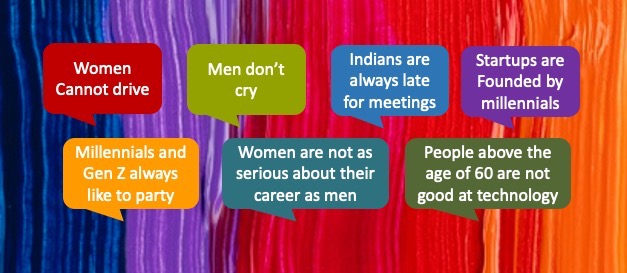
Social Categorisation of people into different groups like ethnicity, gender, sexual orientation, caste, language or any other, also associates them with stereotypes. Stereotype Threat, is when people belonging to these categories internalise the stereotype. Let’s understand this better.
Have you ever been judged? Well if you think this is a stupid question to ask, you’re right. We’re always being judged, on our gender, place where we belong, educational qualifications, height, weight, skin colour … just about everything.
Some of the common stereotypes :
- Women can’t drive – A very popular stereotype and no one
- Men are better engineers
- Millennials are impatient
- Start-ups are by Millennials
- People above 60 years of age are not technologically savvy
Stereotype are defined as assumptions or fixed generalised belief that we have about groups of people.
Stereotypes are harmful, because we analyse individuals not based on their talents but on the groups they belong to. In the west the stereotype that women are not good at Maths is very popular. The fact that India has many women engineers, and many women heading banks in our country, the women and maths holds no weight.
Social Categorisation is a natural cognitive process by which we put individuals in social groups
Social Categorisation and stereotyping are inter-related. The common assumption that Social Categorisation leads to stereotyping, may be true most of the times but not always. e.g. Mohit and Mohita are having lunch together. The social categorisation of gender will remain same irrespective of which part of the world they are having lunch. However, the stereotypes associated with them based on gender will vary.
Impact of Social categorisation
Jane Elliots – Blue Eyes Vs Brown Eyes
In 1968, a teacher in grade 3, Jane Elliot, after the assassination of Martin Luther King Jr, wanted to explain to her students about privilege. She stayed up all night and stitched blue collars and brown collars.
The next day she announced in the class that brown eyed people are smarter, and better human beings than people with other colour of eyes. She put the blue collar for blue eyed kids and asked them to sit at the back of the class, additionally giving certain privileges to the brown eyed children. It was observed, the privileged brown eyed children were more participative in the class and were faster in problem solving abilities.
The second day, she announced to the class that she made a mistake the previous day and in reality the blue eyed people are better. Having made this announcement, she reversed the roles and asked the brown eyed children to put on the collars. It was observed that the privileged blue eyed children today, were more participative and better at problem solving.
Jane Elliot performed this experiment to share with the children how social categorisation & lack of priviledge can negatively impact the performance.
Click here to read our blog on privilege
The case of gender categorisation
Watch this experiment by BBC to understand how we think about the choices of our children based on their gender. Pink and Blue are colours and we have gendered them. It majorly benefits the marketers
Based on the gender, we have categorised the toddlers and accordingly impact our choices for them and hence their choices subsequently. This also impacts the career choices they make based on the category they identify themselves with.
Stereotype Threat
Coined by Dr. Claude Steele when he and his team observed that the undergraduate students who had score equal in the SAT test, were scoring differently during their course. Their analysis found that some categories of students were not performing as well as certain other categories, women were performing less than men in Maths, and African Americans were performing poorly on stardardised academic tests than the white community.
Stereotype threat is internalisation of negative stereotypes associated with the category the individual belongs to.
According to Dr Steel, human beings internalise the stereotypes that are popular for the group they belong to.
In an experiment, two groups of men and women were given a complex maths problem to solve. Before administering the test, the announcement in the first group, that research has shown women and men are equally good at maths and the second group was, women are not as good as men in maths. Unsurprisingly, in the first group, men and women performed equally well in the test whereas in the second group, men performed better.
In another experiment, which involved putting the golf balls in the putt. The first group was told that it was a test of strategy rather than of golf, the white did better. In the second group it was announced, it is a test of physical abilities and the African Americans.
Every day Instances:
Next time when you tell your children, they are useless or you tell them they can’t do anything properly, remember you are training their mind to become that. Instead change the script to, “it’s all right to make mistakes provided they learn something from their mistakes”.
Catch yourself falling into the trap of “Stereotype Threats” and tell yourself “I can do it”. Follow the guidelines of growth mindset to say “I can try and its alright if I don’t get it the first time.”
Way forward
- If there is someone in your group who belongs to a minority with associated stereotypes, ensure you create a safe space for them and not allow stereotypes to colour your thoughts impacting decisions
- If there is a stereotype which is strong in your mind, look for instances which goes against that stereotype. Keep on a lookout for women who drive well, take time out to appreciate them and talk about them.
references ;
- https://open.lib.umn.edu/socialpsychology/chapter/12-1-social-categorization-and-stereotyping/
- https://www.edglossary.org/stereotype-threat/
